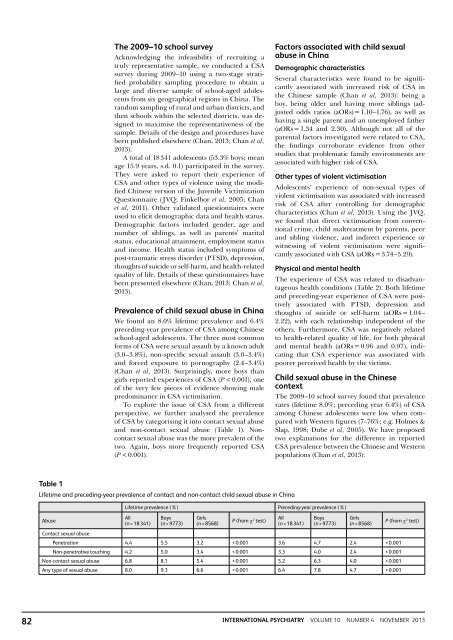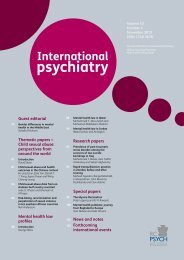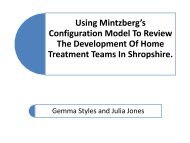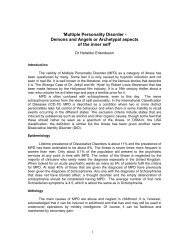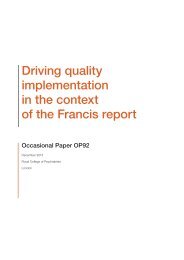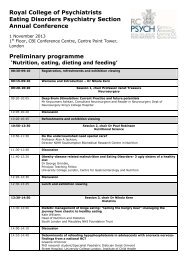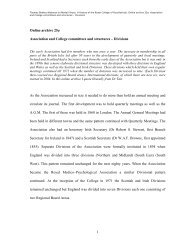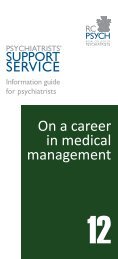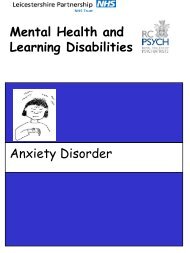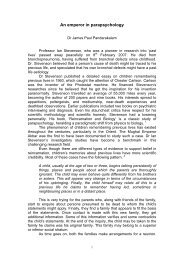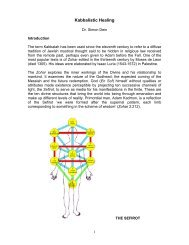Nov 2013 - Royal College of Psychiatrists
Nov 2013 - Royal College of Psychiatrists
Nov 2013 - Royal College of Psychiatrists
You also want an ePaper? Increase the reach of your titles
YUMPU automatically turns print PDFs into web optimized ePapers that Google loves.
The 2009–10 school survey<br />
Acknowledging the infeasibility <strong>of</strong> recruiting a<br />
truly representative sample, we conducted a CSA<br />
survey during 2009–10 using a two-stage stratified<br />
probability sampling procedure to obtain a<br />
large and diverse sample <strong>of</strong> school-aged adolescents<br />
from six geographical regions in China. The<br />
random sampling <strong>of</strong> rural and urban districts, and<br />
then schools within the selected districts, was designed<br />
to maximise the representativeness <strong>of</strong> the<br />
sample. Details <strong>of</strong> the design and procedures have<br />
been published elsewhere (Chan, <strong>2013</strong>; Chan et al,<br />
<strong>2013</strong>).<br />
A total <strong>of</strong> 18 341 adolescents (53.3% boys; mean<br />
age 15.9 years, s.d. 0.1) participated in the survey.<br />
They were asked to report their experience <strong>of</strong><br />
CSA and other types <strong>of</strong> violence using the modified<br />
Chinese version <strong>of</strong> the Juvenile Victimization<br />
Questionnaire (JVQ; Finkelhor et al, 2005; Chan<br />
et al, 2011). Other validated questionnaires were<br />
used to elicit demographic data and health status.<br />
Demographic factors included gender, age and<br />
number <strong>of</strong> siblings, as well as parents’ marital<br />
status, educational attainment, employment status<br />
and income. Health status included symptoms <strong>of</strong><br />
post-traumatic stress disorder (PTSD), depression,<br />
thoughts <strong>of</strong> suicide or self-harm, and health- related<br />
quality <strong>of</strong> life. Details <strong>of</strong> these questionnaires have<br />
been presented elsewhere (Chan, <strong>2013</strong>; Chan et al,<br />
<strong>2013</strong>).<br />
Prevalence <strong>of</strong> child sexual abuse in China<br />
We found an 8.0% lifetime prevalence and 6.4%<br />
preceding-year prevalence <strong>of</strong> CSA among Chinese<br />
school-aged adolescents. The three most common<br />
forms <strong>of</strong> CSA were sexual assault by a known adult<br />
(3.0–3.8%), non-specific sexual assault (3.0–3.4%)<br />
and forced exposure to pornography (2.4–3.4%)<br />
(Chan et al, <strong>2013</strong>). Surprisingly, more boys than<br />
girls reported experiences <strong>of</strong> CSA (P < 0.001), one<br />
<strong>of</strong> the very few pieces <strong>of</strong> evidence showing male<br />
predominance in CSA victimisation.<br />
To explore the issue <strong>of</strong> CSA from a different<br />
perspective, we further analysed the prevalence<br />
<strong>of</strong> CSA by categorising it into contact sexual abuse<br />
and non-contact sexual abuse (Table 1). Noncontact<br />
sexual abuse was the more prevalent <strong>of</strong> the<br />
two. Again, boys more frequently reported CSA<br />
(P < 0.001).<br />
Factors associated with child sexual<br />
abuse in China<br />
Demographic characteristics<br />
Several characteristics were found to be significantly<br />
associated with increased risk <strong>of</strong> CSA in<br />
the Chinese sample (Chan et al, <strong>2013</strong>): being a<br />
boy, being older and having more siblings (adjusted<br />
odds ratios (aORs) = 1.10–1.76), as well as<br />
having a single parent and an unemployed father<br />
(aORs = 1.34 and 2.30). Although not all <strong>of</strong> the<br />
parental factors investigated were related to CSA,<br />
the findings corroborate evidence from other<br />
studies that problematic family environments are<br />
associated with higher risk <strong>of</strong> CSA.<br />
Other types <strong>of</strong> violent victimisation<br />
Adolescents’ experience <strong>of</strong> non-sexual types <strong>of</strong><br />
violent victimisation was associated with increased<br />
risk <strong>of</strong> CSA after controlling for demographic<br />
characteristics (Chan et al, <strong>2013</strong>). Using the JVQ,<br />
we found that direct victimisation from conventional<br />
crime, child maltreatment by parents, peer<br />
and sibling violence, and indirect experience or<br />
witnessing <strong>of</strong> violent victimisation were significantly<br />
associated with CSA (aORs = 3.74–5.29).<br />
Physical and mental health<br />
The experience <strong>of</strong> CSA was related to disadvantageous<br />
health conditions (Table 2). Both lifetime<br />
and preceding-year experience <strong>of</strong> CSA were positively<br />
associated with PTSD, depression and<br />
thoughts <strong>of</strong> suicide or self-harm (aORs = 1.04–<br />
2.22), with each relationship independent <strong>of</strong> the<br />
others. Furthermore, CSA was negatively related<br />
to health-related quality <strong>of</strong> life, for both physical<br />
and mental health (aORs = 0.96 and 0.97), indicating<br />
that CSA experience was associated with<br />
poorer perceived health by the victims.<br />
Child sexual abuse in the Chinese<br />
context<br />
The 2009–10 school survey found that prevalence<br />
rates (lifetime 8.0%; preceding year 6.4%) <strong>of</strong> CSA<br />
among Chinese adolescents were low when compared<br />
with Western figures (7–76%; e.g. Holmes &<br />
Slap, 1998; Dube et al, 2005). We have proposed<br />
two explanations for the difference in reported<br />
CSA prevalence between the Chinese and Western<br />
populations (Chan et al, <strong>2013</strong>):<br />
Table 1<br />
Lifetime and preceding-year prevalence <strong>of</strong> contact and non-contact child sexual abuse in China<br />
Abuse<br />
Lifetime prevalence (%) Preceding-year prevalence (%)<br />
All<br />
(n = 18 341)<br />
Boys<br />
(n = 9773)<br />
Girls<br />
(n = 8568)<br />
P (from c 2 test)<br />
All<br />
(n = 18 341)<br />
Boys<br />
(n = 9773)<br />
Girls<br />
(n = 8568)<br />
P (from c 2 test)<br />
Contact sexual abuse<br />
Penetration 4.4 5.5 3.2 < 0.001 3.6 4.7 2.4 < 0.001<br />
Non-penetrative touching 4.2 5.0 3.4 < 0.001 3.3 4.0 2.4 < 0.001<br />
Non-contact sexual abuse 6.8 8.1 5.4 < 0.001 5.2 6.3 4.0 < 0.001<br />
Any type <strong>of</strong> sexual abuse 8.0 9.3 6.6 < 0.001 6.4 7.8 4.7 < 0.001<br />
82 International Psychiatry Volume 10 Number 4 NOVEMBER <strong>2013</strong>


